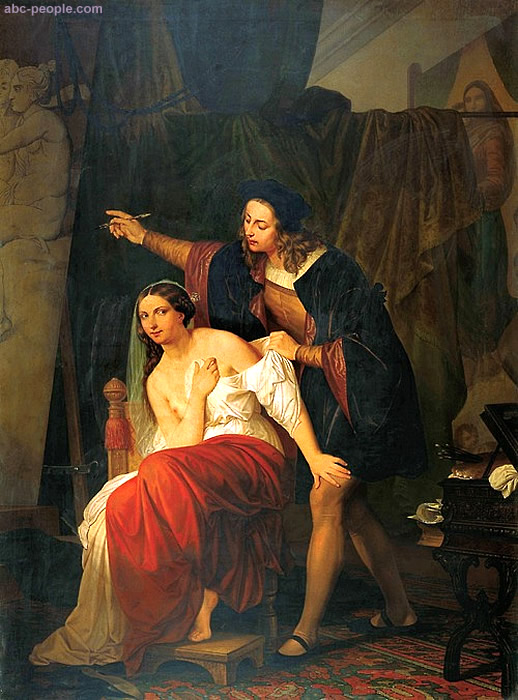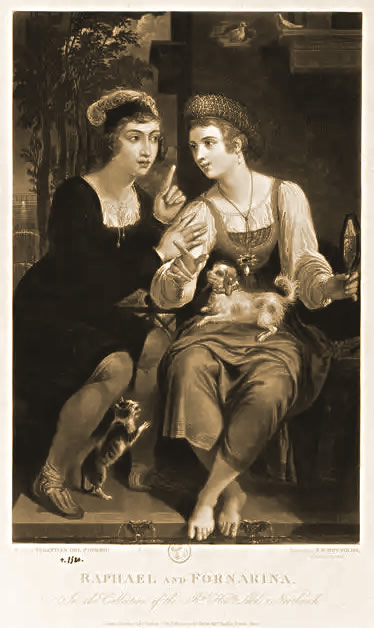| Raphael
Sanzio - Private life |
 |
Raphael
->Main page |
|
Raphael's
love secrets |
|
Secret
of the Raphael marriage |
Raphael's
secret love |
Was Raphael Married? |
|
|
| |
"I
found my Psyche"
Raphael
never married, but in 1514 became engaged to Maria Bibbiena,
Cardinal Medici Bibbiena’s niece. Cardinal Bernardo
had a niece, Maria Bibbiena, who wanted to marry Raphael.
But he wasn’t very enthusiastic about this marriage.
The artist felt that he could not refuse, being placed in
a difficult position due to the cardinal’s enormous
influence. Yet it presented him with a problem – because
Raphael was already secretly in love with the daughter of
a baker, Margherita Luti, a woman often referred to as La
Fornarina (the (female) Baker). He accepted the role as Maria
Bibbiena’s fiance, but continually postponed the marriage,
so that it had still not taken place when he died. Maria in
the end died in 1520 as a maiden. |
|
|
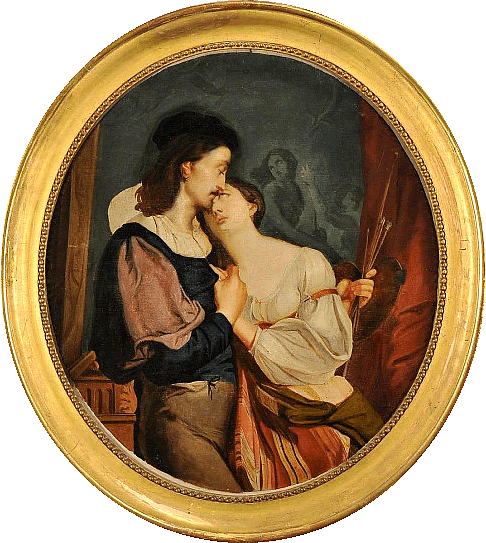 Francesco
Gandolfi
Francesco
Gandolfi
Raphael and La Fornarina
1855 |
Raphael
was handsome as a god. Young, but already famous and very beautiful,
Rafael was engaged in painting the walls of the central gallery
of the Fornesino Palace in Rome. He already wrote two frescoes:
"Three Graces" and "Galatea." But for the third
- "Cupid and Psyche" - could not find the model in any
way.
And
one day, while walking in the park, he saw a young, charming, angelike
Marguerite. Raphael was not deprived of the attention of women.
He was so handsome and attractive that the passers-by of the necks
curled up after him. He was loved by the best beautiful ladies of
the time.
But
he forgot everyone when he saw her. He exclaimed: "I found
my Psyche." And he asked the 17-year-old beauty to pose for
him. At the end of the day, he gave her a gold necklace.
And
the next morning he came to her father, the baker, and gave him
a few gold pieces so that he would let his daughter work for him.
And the more he spent time with her, the more he fell in love. Finally
he paid Luti's father three thousand gold and took his beloved to
Rome.
In
Rome, Rafael put a bunch of servants to her, showered him with gifts
and dresses. Margarita capricious, demanding more and more attention
and dresses. She just took Rafael captive. He did not have time
to work, and in the meantime the customer, nobleman of great honor
Agostino Chigi, urgently demanded the completion of the work. He
singled out in his palace a separate room for lovers, only for Raphael
to hurry.
Meanwhile,
ex-boyfriend of Margaret Shepherd Tomaso arrived at the palace.
He sent her a furious letter with threats. She sought the help of
nobleman asked him to not only cool the ardor of Man, and imprison
him in a monastery. Chigi fulfilled her request. In gratitude, the
girl immediately gave herself to him, while Rafael worked practically
in the next room. |
|
|
| |
Then
she seduced the young apprentice Raphael. His disciples found out
about this and summoned the boy to a duel. To them, this betrayal
seemed insulting. The guy died of blood loss. But "little Fornarina"
(as she called Raphael) did not even think about the consequences
of her love. She already found the next victim.
Raphael
watched silently as she returned in the mornings drunk. And he did
not say anything. He suffered so much that he could not always get
out of bed in the morning. Raphael lost weight, he almost did not
eat. Doctors diagnosed "a sharp exhaustion of the body."
He continued to portray Fornarina as a model for his paintings.
He knew about her treason. I knew that she had become one of Rome's
most dissolute courtesans. Rafael tried to fix it, waiting for her
to come to its senses, to change, that his love will win. But the
weary heart of the master could not stand it. It stopped April 6,
1520. He was only 37 years old. And he could write many more pictures.
He was buried in the Pantheon, among the great men of Italy.
The
pupils of the artist vowed to take revenge on Margarita. And she
ran to her father. There she was met by the shepherd Tomaso, to
whom she broke life - he spent five years in prison. Seeing him,
Margarita found nothing better than to bare her shoulders and chest,
trying to seduce the former groom. But he threw a handful of earth
into it and left. Margarita Luti finished her life in the monastery. |
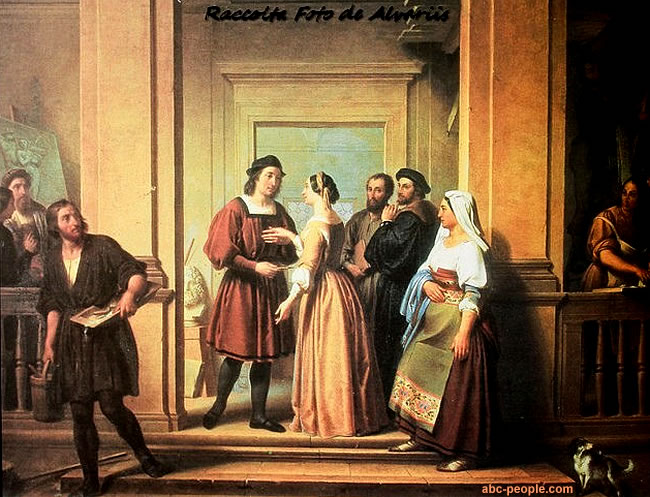 Filippo
Bigioli
Filippo
Bigioli
1517 Palazzo Caprini, Raffaello meets Fornarina
1830 ca, Palazzo Caprini |
|
|
|
| Art
sleuth uncovers clue to secret Raphael marriage
by Barbara McMahon |
| |
The
small pearl brooch in Raphael's masterpiece, La Fornarina, was
the clue, and researchers believe that it has unlocked one of
the mysteries of the Renaissance. For centuries it has been
thought that the woman, Margherita Luti, a baker's daughter
from Siena, was the artist's mistress. He was, after all, engaged
to the niece of a powerful Vatican cardinal. However, a new
study by an Italian art historian, Maurizio Bernardelli Curuz,
suggests that Raphael and Luti had already married in a clandestine
ceremony, and that - fearful of a scandal - the artist took
the secret to his grave. Officially, he died a bachelor at the
age of 37. |
|
|
| |
"It
was an impossible love affair," said Mr Bernardelli Curuz.
"It is hard to overstate Raphael's status in Rome. He
was a superstar. The distance separating them was like that
which today would separate George Clooney and his cleaner."
La
Fornarina is one of the painter's most suggestive portraits.
Half-clothed and with a coy expression that has been likened
to the Mona Lisa, the dark-eyed beauty has a diaphanous veil
over her stomach and suggestively cups her left breast. Mr
Bernardelli Curuz, editor of Stile magazine in Milan, which
conducted a year's research into the romantic riddle, says
a string of nuptial allegories in the portrait point to the
secret marriage.
The
biggest clue, he says, is the brooch pinned on to the fashionable
silk turban of La Fornarina, the kind of expensive bauble
a woman would wear on her wedding day. The pearl, also included
in another portrait of a woman, La Donna Velata, reinforces
the theory that the sitter's name was Margherita - a Latin
word for pearl - and not Maria Bibbiena, the artist's intended
bride. There are other matrimonial hints, according to the
art expert, from the blue ribbon on the woman's arm bearing
Raphael's name - an unusual way to sign a portrait - to a
ring on her left hand that was later covered up by Raphael's
students. |
|
| |
Cesare
Mussini
(Berlin, June 5, 1804 – Florence, May 24, 1879)
Raphael Undressing La Fornarina
for the first time
1837, oil in canvas
Dimensions: 184.5 cm x 248 cm
|
|
| |
Historical
information: The painting commissioned by the artist of the
Marquis Ala Ponzoni in 1837 entered the Academy collection directly
due to the same Marquis (1889). Made in 1837, he was immediately
exhibited at the Florentine Academy and, next year, in Brera,
where he received decisions favorable to the greater accessibility
of the cultural environment to accept without debate the issue
of disappointed women. In 1861, the painting was again exhibited
at the first Italian national exhibition. The painting became
so popular that right now they were made of lithographs made
by Girolamo Tobin for the printing of Stefani from Florence,
the Onofrio design of Diofebi for the limousque Barozzi in Venice,
and in 1841, even Mussini, he executed a copy of "and half
the truth" for Count Colovrat. |
|
|
|
|
| |
|
|
|
| |
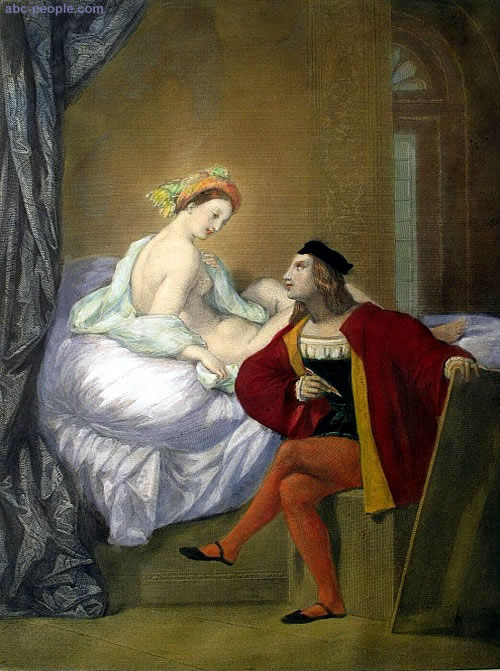
|
|
| |
In addition, the portrait is painted with
background foliage of myrtle and quince, symbols of love,
fecundity and fidelity. Such allegories, says Mr Bernardelli
Curuz, "may seem artificial to us, but these were everyday
games at the Renaissance courts. "At least until the
18th century, the allegorical side of painting was extremely
important. It was Impressionism that dampened our ability
to read a painting like a book."
La
Fornarina has long fascinated admirers of Raphael's work.
In 1814, the French artist Jean-Auguste-Dominique Ingres painted
La Fornarina sitting on the artist's knee. A century later,
Picasso portrayed their trysts in a series of explicit drawings.
The novelist Honore de Balzac also mentioned the couple. However,
Raphael's students made efforts to draw a veil over Luti's
existence, according to Mr Bernardelli Curuz. The painting
was unfinished when the artist died and was completed by his
students who covered up the bushes and the tell-tale ring.
They
were uncovered during a recent cleaning. "At the time
of his death, Raphael's school was painting the Sala di Constantino
in the Vatican, and losing that commission could have meant
bankruptcy," he said.
"He
had left La Fornarina unfinished, and the students began to
fret about the landscape, the ring, anything that could tie
it to the marriage." To silence the rumours, Raphael's
students placed a plaque on his tomb in memory of his fiancee,
Bibbiena - and Luti was sent away. Four months after the artist's
death in 1520, the convent of Sant'Apollonia in Rome's Trastevere
quarter registered the arrival of "widow Margherita",
daughter of a Siena baker.
Mr
Bernardelli Curuz said he had found evidence to support his
theory from contemporary documents and x-rays of the painting.
"Of course this is not just about the pearl, nor is it
just about the documents," he said. "The absolute
certainty comes from the way everything fits together. But
the pearl was what tipped us off."
© McMahon,
Barbara. "Art sleuth uncovers clue to secret
Raphael marriage." The Guardian. Accessed 19 Jul. 2012.
|
|
| |
Engraving
in the etching by
Louis-Jean-Désiré Delaistre (Paris, 1800-1871),
after Devéria
Raphaël et la Fornarina
circa 1840
|
|
|
|
| |
| |
Raphael’s
secret love, hidden in his paintings
by Karin Maraney |
|
| |
The
art world has always been influenced by collectors and powerful personalities
who entrust to artists the task of committing their favorite images
and values to a painting or sculpture, with the aim of celebrating
their prestige and becoming immortal. In this way, many people over
the centuries have hoped to leave a sign of their lives, one that
will be remembered long after their deaths. |
|
|
| |
This
was particularly true during past times when talented artists were
dependent on patronage, meaning that they had no choice but to satisfy
the requests of those who were powerful during their times. These
people were the ones with the financial ability and the desire to
have their images or ideas immortalized through art.
Given
that art is a personal matter for the artist, and that many artists
prefer to use their creations to express something important to
them, it should be no surprise that many of the artists who worked
on commissions for the rich and powerful found secret ways to express
their real feelings and beliefs in their paintings. In this way,
they could create something which on a surface level represented
what they had been requested to paint, but in fact held a whole
separate world of symbols and declarations which would only be understandable
to someone taking a closer look.
Master
artist Raphael (Raffaello Sanzio da Urbino) (1483-1520) was a professional
Italian painter and architect who was famous for his kindly nature,
his relaxed attitude to court life and his considerable beauty –
aside from his reputation for his able use of colors and his tremendous
artistic talent. One of the more influential personalities of Raphael’s
era was Cardinal Bernardo, a powerful man of the Church who commissioned
art from Raphael on a regular basis.
Cardinal
Bernardo had a niece, Maria Bibbiena, who wanted to marry Raphael.
The artist felt that he could not refuse, being placed in a difficult
position due to the cardinal’s enormous influence. Yet it
presented him with a problem – because Raphael was already
secretly in love with the daughter of a baker, Margherita Luti,
a woman often referred to as La Fornarina (the (female) Baker).
He accepted the role as Maria Bibbiena’s fiance, but continually
postponed the marriage, so that it had still not taken place when
he died. |
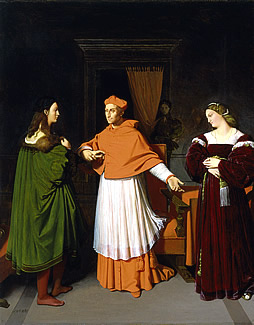 Jean
Auguste Dominique Ingres (1780–1867)
Jean
Auguste Dominique Ingres (1780–1867)
The Betrothal of Raphael
and the Niece of Cardinal Bibbiena
Oil on paper mounted on canvas, 1813-1814
Walters Art Museum, Baltimore
Click
to enlage  |
|
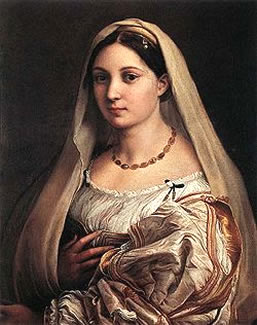 La
velata, or La donna velata
La
velata, or La donna velata
("The woman with the veil"),
is one of the most famous portraits by
the Italian Renaissance painter Raphael.
Click to enlage  |
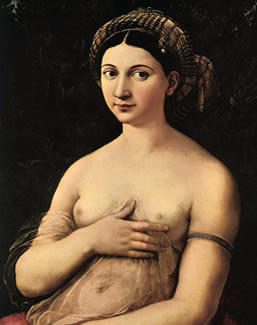 Fornarina
- painting by Raphael,
Fornarina
- painting by Raphael,
depicting Fornarina
(Margherita (Margaret) Luti)
is believed that she was the mistress of artist.
Click to enlage  |



Raphael’s
mistress was his favorite female model from 1508 onwards, and in
fact the protagonist of some of Raphael’s most famous portraits:
La
Fornarina and La
Velata.
Raphael
was not free to declare his love and commitment to her, so while
he was Maria Bibbiena’s official fiancé, he kept hiding
marriage vows and love symbols in his paintings, such as a myrtle
bush, associated with love and marriage, a wedding ring (removed
from La Velata and now only visible through scientific analysis),
a bridal vest, and accessories decorated with Raphael’s name.
In
addition, both portraits include pearls which the artist chose to
decorate the hair of the sitter. The reason for this was likely
because the word for ‘pearl’ was originally ‘Margarita’
– a clear reference to the name of his beloved.
|
|
|
| |
| |
In
Fornarina, in addition to the angelic face, Raphael attracted
her large breasts. Since he bought a girl from his father for
decent money at that time - 50 gold ducats, he considered the
magnificent bust of the girl as his property. Strange as it
may seem, Rafael did not want others to see his treasure. And
drawing a beautiful Bunny, greatly reduced the size of her breasts.
It's no wonder that all of his role-players (including a beloved
- like Zeus seduced Danai) revolved around the huge "rolls"
of Fornarina. According to Italian historians, it was this amateur
mammologist who invented then a new kind of sexual stimulation,
which is now called "tits rape" (instead of the vagina
male penis sexually attacks the female breast). And he indulged
in this passion very passionately, obsessively and often.
And if you believe the evil contemporaries, just during the
next "rape" Fornarina, who never refused him, a sexually-exhausted
great artist and died at the age of only 37 years.
If this was true, then, presumably, Rafael died absolutely happy.
In Italy, it was sacredly believed, and since then, the dead
on the lovers' bed of men are seen off in the last way with
the words: "He
died like Raphael." |
|
|
|
| |
Due
to Raphael’s premature death at 37, he could not complete
what studies suggest was his last portrait of his favorite model.
She herself decided to retire to a convent four months after his
death, and history has lost sight of her after that time.
We
can all still admire Raphael’s devotion to his Margherita
and continue to search for the secret symbols in his paintings that
will never stop declaring his commitment to his loved one. And if
you enjoy this, perhaps you would like to start exploring what further
surprises and hints are waiting to be discovered in the paintings
of artists who were painting for commissions but managed to slip
into the works references to their own personality and ideas!
© KARIN MARANEY, 2011. Agoraartgalleryblog
- http://agoraartgalleryblog.com |
|
|
|
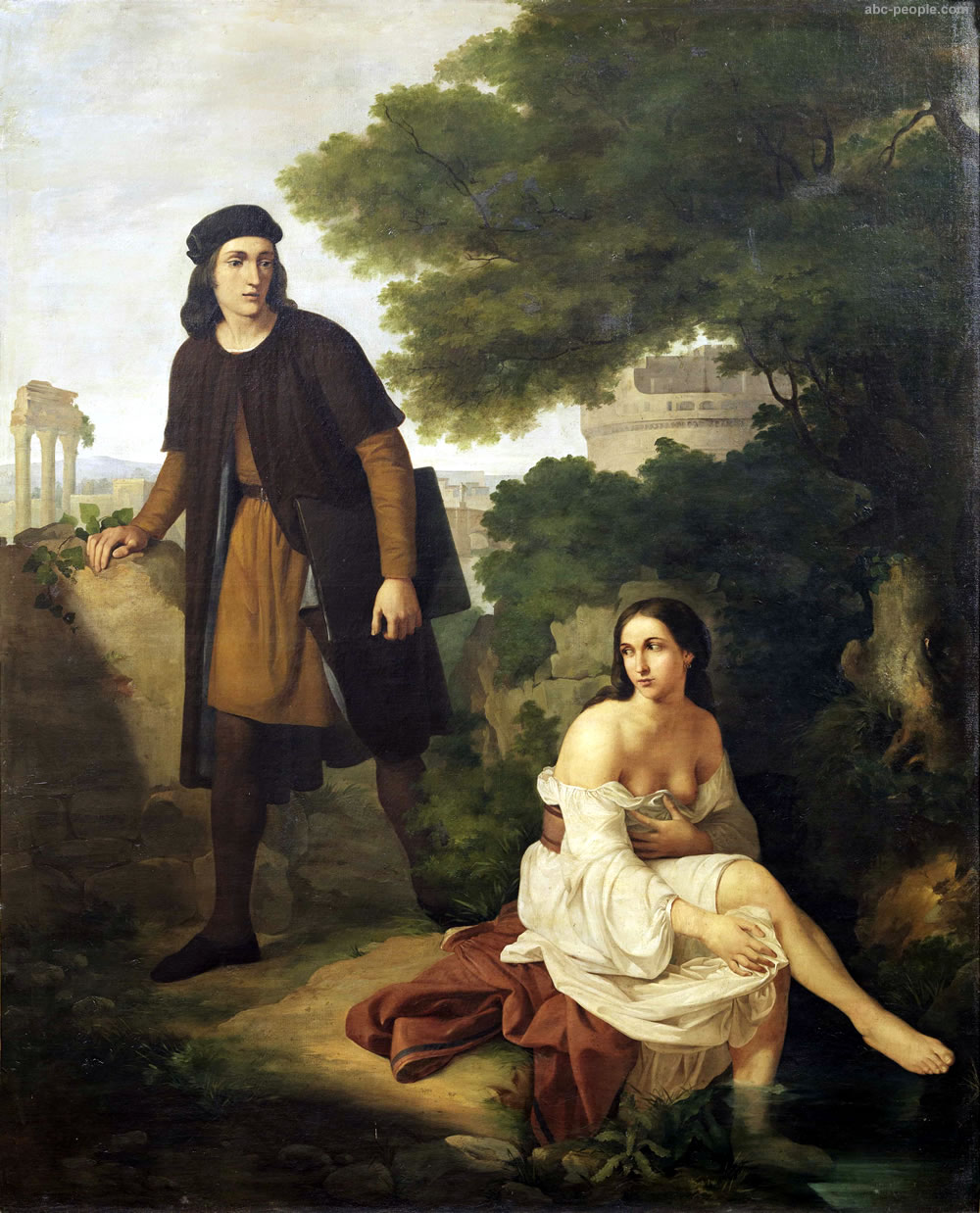
German
painter of the nineteenth century
Raffaello and Margarita Luti on the background
Castel Sant'Angelo
Oil on canvas,
1813-1814
170x137 sm
|
| |
The
story of Raffaello and Fornarina was one of the myths of nineteenth-century
classicism, both in France and Germany.
In this painting, Raffaello captures the beauty of Fornarina,
who, like Susanna, is getting wet.
The theme of Raffaello and Fornarina was often dealt with
in the most iconic painter's iconography in the studio while
painting his portrait and the woman embraces him affectionately,
as in J.A. Dominique Ingres (1780-1867) already in the collection
of the painter Müller (Raphael et art français),
Jules Sully (1814-1900) already in Nimes, while this version,
with the painter discovering Fornarina at the bath, is never
depicted. There are also some engravings, such as the Fornarina
assisi between the plants of Achille Devéria (1800-1857),
lithography, and that of Francesco Garnier (active in the
Salon from 1824 to 1850), reproducing a painting by Picot
of 1822, in which the two lovers are portrayed outdoors under
the Cupid statue with the landscape of Rome and St. Peter
in the background. Raffaello's effigy recalls here the usual
one with the beret on his head. But our painting, more than
French, would be stylistically close, albeit behind, to examples
of German painters in Rome, close to the Nazarenes, such as
FW Schadow (1788-1862), JES von Leonardshoff (1795-1822),
JVH Schnorr von Carolsfeld (1794-1872). |
|
|
|
| |
| |
Was
Raphael Married?
by Melissa Snell |
Samuel
William Reynolds Jr.
Raphael and La Fornarina
Litography, 1826
Castle of Versailles |
| |
He
was a Renaissance celebrity, known not only for his superb artistic
talent but for his personal charm. Very publicly engaged to Maria
Bibbiena, the niece of a powerful cardinal, scholars believed him
to have had a mistress by the name of Margherita Luti, the daughter
of a Sienese baker. Marriage to a woman of such a lowly social status
would hardly have helped his career; general public knowledge of
such a liaison could have damaged his reputation.
But
recent research conducted by Italian art historian Maurizio Bernardelli
Curuz suggests that Raphael Sanzio may have followed his heart and
secretly married Margherita Luti.
CLUES
THAT POINT TO A MARRIAGE
Important
clues to the relationship can be found in the recently-restored
"Fornarina," the portrait of a seductive beauty begun
in 1516 and left unfinished by Raphael. Half-clothed and smiling
suggestively, the subject wears a ribbon on her left arm bearing
Raphael's name. Pinned to her turban is a pearl and the meaning
of "Margherita" is "pearl." X-rays taken during
restoration reveal in the background quince and myrtle bushes --
symbols of fertility and fidelity. And on her left hand was a ring,
the existence of which was painted out, probably by Raphael's students
after the master's death.
All
these symbols would have been extraordinarily meaningful to the
average Renaissance viewer.
To
anyone who understood the symbolism, the portrait practically shouts
"this is my beautiful wife Margherita and I love her."
In
addition to the portrait, Curuz has uncovered documentary evidence
that Raphael and Margherita were married in a secret ceremony. Curuz
also believes Margherita to be the subject of "La Donna
Velata" (the Veiled Lady), which one contemporary
noted was the painting of the woman Raphael "loved until he
died."
It
had been theorized that Raphael didn't paint the Fornarina at all,
and that instead it is the work of one of his pupils. Curuz and
his associates now believe that Raphael's pupils deliberately obscured
the nuptial symbolism to protect his reputation and continue their
own work at the Sala di Constantino in the Vatican, the loss of
which would have bankrupted them. To reinforce the pretense, Raphael's
students placed a plaque on his tomb in memory of his fiancee, Bibbiena.
And
Margherita Luti (Sanzio)? Four months after Raphael's death, the
"widow Margherita" is recorded as arriving at the convent
of Sant'Apollonia in Rome.
From: thoughtco.com |
|
|
 Joseph
Mallord William Turner
Joseph
Mallord William Turner
Rome, from the Vatican. Raffaelle, Accompanied by La Fornarina
Preparing his Pictures for the Decoration of the Loggia
Oil on canvas, 1820 |
|
| |
 |
Back
to
Raphael-main page |
|
|
| |
|
Copyright
© 2004 abc-people.com
Design and conception BeStudio © 2014-2023 |
|
|

